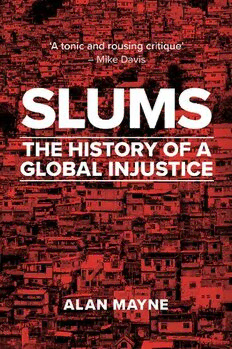Table Of ContentSLUMS
SLUMS
THE HISTORY OF A
GLOBAL INJUSTICE
ALAN MAYNE
Reaktion Books
Jude
My companion on the way
Published by Reaktion Books Ltd
Unit 32, Waterside
44–48 Wharf Road
London n1 7ux, uk
www.reaktionbooks.co.uk
First published 2017
Copyright © Alan Mayne 2017
All rights reserved
No part of this publication may be reproduced, stored in a retrieval system,
or transmitted, in any form or by any means, electronic, mechanical,
photocopying, recording or otherwise, without the prior permission
of the publishers
Printed and bound in Great Britain
by TJ International, Padstow, Cornwall
A catalogue record for this book is available from the British Library
isbn 978 1 78023 809 8
contents
INTRODUCTION 7
1 ‘SLUM’ and ‘SLUMMING’ 16
2 THE ATTRACTION of REPULSION 40
3 THE WAR on SLUMS 89
4 ORIENTALIZING the SLUM 131
5 NEW SLUMS in a POSTCOLONIAL WORLD 157
6 LITTLE PALACES 192
7 BUILDING COMMUNITIES? 234
8 SHADOW CITIES 248
CONCLUSION 283
RefeRences 289
select BiBliogRaphy 341
acknowledgements 348
index 349
INTRODUCTION
South Delhi, 2006. We stop beside a dusty though neatly
maintained camp of a dozen makeshift tents. They are
squeezed between a wall and the verge of a highway that is
crammed with honking cars, buses, motorbikes, and auto
rickshaws. Washing hangs on lines strung between the tent
poles, the wall, and overshadowing trees. Several groups of
labourers and their families sit beside the tents and tend
cooking fires in the bare earth. They are relaxed. As long
as they continue to pay, the police and local politicians are
likely to leave them alone.
The men are polite but cool towards us. They have
worked hard since early morning in Delhi’s booming con-
struction industry, and they are tired. No, they don’t want
their photographs taken. Other outsiders have taken photo-
graphs in the past, and spoken about changes for the better,
of model homes to replace the city’s ‘slums’, but things have
remained just the same. However one young mother smiles
at us. ‘Show me to the world,’ she says, ‘because I am young
and beautiful.’
O ver half of all humanity now live in urban settings similar to those
I saw beside that South Delhi highway and in other nearby places
when I lived in India’s national capital, where the conspicuous wealth
displayed by a few contrasts with widespread and entrenched inequality
and outright poverty. The United Nations’ Millennium Declaration in
2000 drew attention to the enormity of this situation across the world,
7
SLUMS
estimating that over one billion people were caught in ‘the abject and
dehumanizing conditions of extreme poverty’. The Declaration adopted
the slogan ‘Cities Without Slums’, and pledged to achieve ‘significant
improvement in the lives of at least 100 million slum dwellers’ by 2020.1
In 2012 the United Nations Secretary General, Ban Ki-moon, expressed
satisfaction that already the living conditions of ‘more than 200 million
people living in slums have been ameliorated – double the 2020 target’.2
In 2015 he oversaw the launch of the United Nations’ latest initiative
to end global poverty, the 2030 Agenda for Sustainable Development,
which continues the earlier commitment to ‘upgrade slums’.3
It is questionable, however, whether ‘amelioration’ was the best word
to describe the interventions, evictions and forced demolitions that have
been carried out since 2000 by governments, their business allies and
their backers in the United Nations and international development
banks in the name of poverty eradication. In any case, ‘dehumanizing’
and ‘slum’ are inappropriate words with which to characterize urban
social disadvantage. These words, and the constellation of stereotypes
within which they sit, misrepresent the lives, livelihoods and prospects
of the urban poor. They stand in the way of the fundamental changes
in both community knowledge and public policy that are urgently
required to overcome social disadvantage in an ever-urbanizing world.
‘Slum’ is an especially unhelpful word. It misrepresents the com-
plex realities of urban social inequality, whether in New Delhi today,
in nineteenth-century London where the word was first coined, or
in countless other places across time and space. It marginalizes poor
people and low-income areas as supposedly deficient and dysfunctional
by-products of urban development. It discounts the knowledge and
practices of disadvantaged communities and imposes outsiders’ precepts
and agendas for change upon their lives. It will forever do so because
such thinking has so conditioned the word’s meaning over the 200 years
of its use that it has become embedded in its very essence.
‘Slum’ is a fundamentally deceitful construct. A deceit is by
definition:
The action or practice of deceiving; concealment of the truth
in order to mislead; deception, fraud, cheating, false dealing.
An instance of deception; an act or device intended to
deceive; a trick, stratagem, wile.
The quality of deceiving; deceitfulness.4
88

